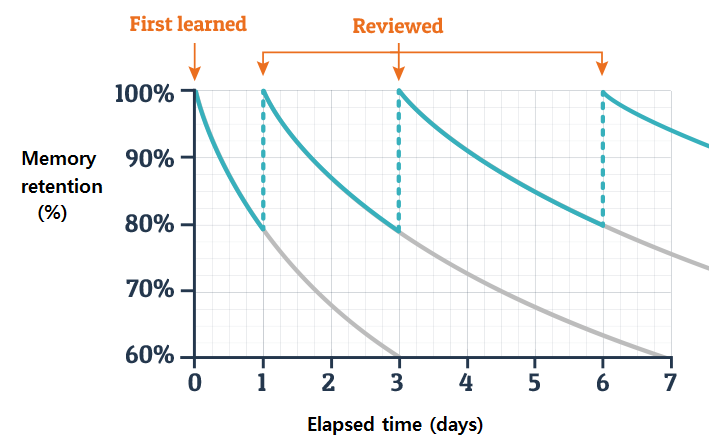Spaced repetition – studying for exams
Dear Friend,
Hope everyone is enjoying the lovely weather this week. It’s nice to finally see the sun – hopefully we can all top up on our Vitamin D levels. Exam season can be a very stressful time of the year for students – there is pressure to perform well. Many universities during exam time can become a toxic environment. Medics for some reason have the inherent capability to try and compete with each other, even if its subconscious. This can start to affect our sleep, mood, eating habits…
Like most students, I used to find exam season quite stressful. However, as I progressed through the years, I developed strategies that helped me concentrate and retain more information. This gave me confidence each successive year, that no matter what my peers were doing, I should trust in my own process that had served me to well. That’s why this week I wanted to share with you the spaced repetition way of studying for exams. Hopefully you find it useful.

Spaced Repetition
As its name implies, spaced repetition involves spacing out your study sessions and reviewing subjects, preferably through active recall, at specific intervals over time.
This concept can be elucidated by the “forgetting curve,” a notion present in psychology literature for over a century. The forgetting curve posits that we tend to forget information at an exponential rate over time, similar to the decay of radioactive substances.
The key to leveraging the forgetting curve lies in breaking the cycle by reviewing material at spaced intervals. While this might seem obvious, its significance cannot be overstated. The more we practice and space out our repetitions, the more likely we are to solidify this information in our long-term memory.
Essentially, spaced repetition involves allowing the brain to forget some information to make the process of active recall mentally challenging. Psychological studies suggest that the greater the effort the brain expends to retrieve information, the more likely it is to be encoded.
By spacing our repetitions over intervals of a day, three days, and then a week, we intentionally allow ourselves to forget some information. This way, when we review the topic through active recall, it requires active mental engagement. Contrastingly, simply rereading material is less effective because it’s a passive exercise. Research indicates that testing oneself once is more effective than rereading the same passage multiple times.
Furthermore, evidence suggests that within a single study session, spaced repetition can enhance information retention. A 2011 study involving four groups of students learning Swahili vocabulary found that even recalling information within the same session yielded significant benefits. Notably, the group that spaced their recall showed remarkable improvements.
The students performed identical tasks, with the only distinction being the spacing of their recall. This study underscores the potency of active recall and provides compelling evidence for the efficacy of spaced repetition. Minor adjustments in our study routine can yield substantial enhancements in our ability to retain and recall information.
This combination of active recall and spaced repetition can be seamlessly integrated into our study habits. For example, after studying Topic 1 and Topic 2 in the morning, it’s beneficial to revisit Topic 1 through active recall before moving on to Topic 3. This process can be repeated for Topic 2 after studying Topic 3, and so forth.
In summary, spaced repetition over days and weeks, along with reviewing content on the same day, can greatly enhance exam performance.
Best of luck in your exams!
See you next week!
Drug of the week
Syntocinon
This is a synthetic version of the hormone oxytocin which is produced naturally by the body.
As a medication, it is used to cause contraction of the uterus to induce labour, and also to stop post-partum haemorrhage.
It is given by injection either into muscle or into a vein.
Common side effects in the mother include nausea and slowing of the heart rate. Serious side effects include uterine rupture and with excessive doses, water intoxication (due to its chemical similarity with ADH).
A Brain Teaser
A 32-year-old man presents with a severe, intermittent, daily, right-sided frontotemporal headache over the past 4 weeks. It seems to occur early in the morning, around the same time each day and lasts for approximately 2 hours. The pain makes him feel nauseous although he has not vomited. He has been significantly stressed with work difficulties recently. Interestingly, he also reports his right eye sometimes appears red and painful with increased lacrimation. He has no loss of visual acuity.
What is the most likely underlying diagnosis?
A: Acute angle-closure glaucoma
B: Brain tumour
C: Cluster headache
D: Migraine
E: Tension headache
Answers
The answer is C – Cluster headache
Cluster headaches tend to affect men more than women and are characterised by ‘clusters’ of intermittent severe frontotemporal headaches lasting up to 2 hours usually at a time with ipsilateral autonomic disturbance.
In glaucoma, you would expect there to be a change in visual acuity.
Headaches related to brain tumours would not demonstrate ipsilateral autonomic disturbance (eye lacrimation) and would not tend to be so severe and intermittent.
Migraine is a possibility here, however again, you would not expect the ipsilateral autonomic disturbance. It would be unusual to be so frequent over the course of a 4 week period.
Tension headache is unlikely here as these are usually a less severe and bilateral headache without autonomic disturbance.




